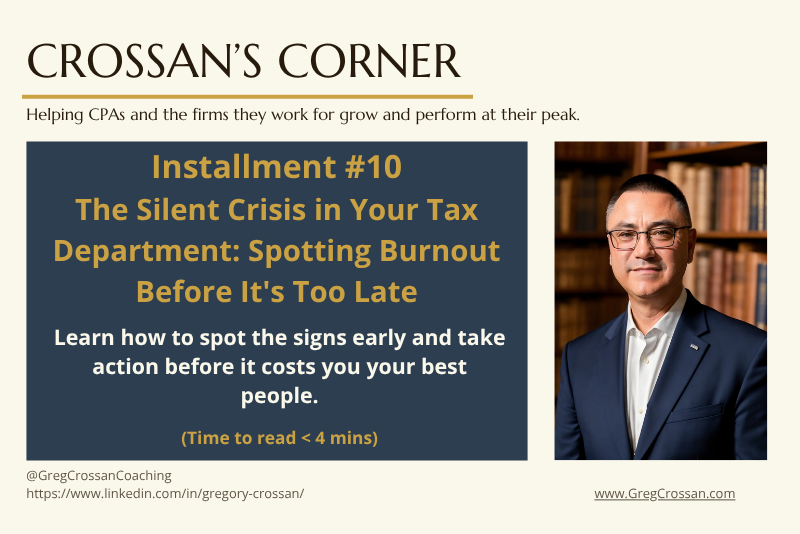The Silent Crisis in Your Tax Department: Spotting Burnout Before It's Too Late
Early Warning Signs of CPA Burnout and Quiet Quitting in Your Tax Department
Picture this: Your star senior associate who used to stay late perfecting client work now logs off at exactly 5 PM. Team meetings feel lifeless. The innovative ideas that once flowed freely have dried up completely.
Sound familiar? You're not alone.
Recent studies reveal that 99% of accountants experience burnout symptoms during their careers, while public accounting firms lose 41% of staff within three years, it’s significantly higher than corporate roles at 28%. The cost? Not just turnover, but the quiet disengagement happening right under your nose.
The Hidden Difference: Quiet Quitting vs. Burnout
Here's what many leaders miss: quiet quitting is the symptom, burnout is the disease.
Quiet quitting = doing the bare minimum, withholding discretionary effort
Burnout = chronic workplace stress leading to exhaustion, cynicism, and reduced efficacy
Addressing one without the other is like treating a fever while ignoring the infection.
Why Tax Professionals Are at Higher Risk
Tax departments face a perfect storm of burnout triggers:
Seasonal intensity creates brutal workload spikes with insufficient recovery time. Constant regulatory changes demand continuous learning that competes with billable hours. Perfection-driven culture breeds fear of mistakes, while compressed deadlines leave zero margin for error or restoration.
If perfectionist standards are part of what is driving the strain, read 7 Ways CPAs Can Beat Perfectionism Without Lowering Standards.
The Early Warning System: What to Watch For
Individual Red Flags
Energy shifts: Late arrivals, excessive caffeine dependence, frequent absences
Emotional withdrawal: Increased sarcasm, minimal participation in team discussions
Performance changes: Slower work pace, minor errors in previously flawless deliverables
Digital detachment: Cameras off in meetings, minimal chat participation
Team-Level Indicators
Rising turnover immediately post-busy season
Quality degradation with increased write-offs and rework
Innovation drought with fewer process improvements suggested
Knowledge hoarding replacing collaborative best-practice sharing
Your Intervention Toolkit
Start with data, not assumptions. Deploy pulse surveys during busy season to track engagement in real-time. Create workload heat maps that visualize overtime distribution before fatigue peaks.
Never built a workload dashboard? Start simple. Most firms already track hours in systems like Thomson Reuters or CCH. Export this data weekly into Excel or Google Sheets. Create color-coded charts showing each person's hours against their target (green = sustainable, yellow = approaching burnout, red = intervention needed). Free tools like Tableau Public or Power BI can automate this process, while project management platforms like Monday.com or Asana offer built-in workload views. The goal visibility, not perfection.
Make mental health a business metric. Include capacity discussions in one-on-ones. Redistribute tasks when loads become unsustainable. Celebrate efficiency improvements, not just billable hours.
Build in recovery rituals. Institute mandatory break days after deadlines. Try micro-interventions like five-minute breathing exercises or walking meetings.
Success Story: From Disengaged to Re-Energized
A mid-level tax manager began withholding questions and skipping learning events mid-busy season. Instead of assuming he was coasting, leadership used an assessment tool that revealed his stress response had shifted into self-protection mode.
The solution? Reallocated one complex project and paired him with a mentor for support. Within two months, he proposed an automation process that saved 40 hours per filing cycle and volunteered to lead the process-improvement committee.
Investment: Minimal coaching and workload adjustment
Return: Retained emerging leader plus measurable efficiency gains
Your 90-Day Action Plan
Week 1-2: Deploy pulse surveys and create workload visibility dashboards
Week 3-4: Train managers on burnout recognition and conduct team assessments
Month 2: Create psychological safety first—many employees won't honestly discuss workload challenges if they fear being seen as weak or incapable. Start team meetings by acknowledging that sustainable workload is a business strategy, not a personal failing. Share your own capacity challenges as a leader. Make it clear that raising workload concerns demonstrates professionalism, not inadequacy.
Month 2 (continued): Implement recovery protocols and recognition programs
Month 3: Evaluate results, celebrate those who spoke up about challenges, and refine based on feedback
The Bottom Line
Burnout doesn't announce itself, it whispers through missed opportunities, quiet keyboards, and the gradual loss of your best talent. The firms that listen early will retain their competitive edge while others scramble to replace irreplaceable knowledge.
Your next step: Start with one simple question this week. Ask your team: "On a scale of 1-10, how sustainable does your current workload feel?" Their answers might surprise you.

